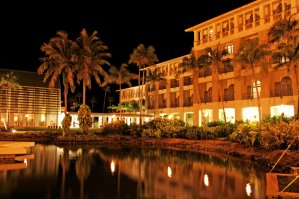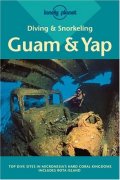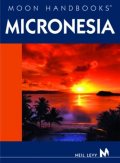GUAM
 Located in the Western Pacific Ocean, 1,600 miles south of Japan, Guam is the southernmost of the Mariana Islands and is the largest island in Micronesia. Located in the Western Pacific Ocean, 1,600 miles south of Japan, Guam is the southernmost of the Mariana Islands and is the largest island in Micronesia.
Guam lies along the deepest trench in the world - the Marianas Trench. Two of the earth's plates meet here and so the island experiences occasional earthquakes.
In the north of the island is a limestone plateau of rolling hills and in the south there are volcanic peaks and many waterfalls. A coral reef surrounds most of the island.
One third of the entire island is taken up by United States armed forces bases and it is this, plus tourism (with the benefits of tax free shopping), that forms the mainstay of the island's economy.
This island is the most developed in Micronesia. It has traffic congestion, fast food restaurants, malls and even a University. It is also very Americanised - they even have a replica of the Statue of Liberty in the capital.
One downside for any Ophidiophobes reading. Guam has the highest density of snakes in the world.
Weather
Normally warm and humid, the only major seasonal variation is that there is higher rainfall with occasional tropical storms between the months of July and November, with an increased risk of typhoons in October and November.
How to get there
Guam is very well connected with seven airlines flying there regularly. From Won Pat International Airport (about 6km from the capital of Hagatna) there are around 100 flights every week to Hawaii and the US mainland, Australia, New Zealand, Japan, Hong Kong, Korea, Taiwan, the Philippines and Indonesia. There are also flights to a number of other Micronesian islands.
Apra Harbour is visited by cruise ships. There is also a marina for visitors with their own yachts.
Where to stay
Tumon Bay on the west is the island's biggest resort with a large number of luxurious, international-standard hotels lining the beach front. Some of these even have direct access to shopping malls and Underwater World (a walk-though tunnel aquarium).
Tumon Bay has everything you would expect in a top class resort.
Most of the accommodation on the island is to be found along the coast from Tumon Bay to the capital, Hagatna, with a few hotels in the south and east of the island.
What to see
and do
South of Guam, Cocos lsland is a small island surrounded by reefs. The lagoon around Cocos is perfect for snorkelling, jet skiing and windsurfing. A Spanish galleon was wrecked not far from here and the treasure still lies undiscovered.
Mount Humuyong Manglo is not only the highest mountain on Guam, but also, if measured from the sea floor, the highest mountain in the world.
Hagatna is easily explored on foot. Once a Spanish territory, many of the buildings reflect this in the architecture.
The Guam Museum in Hagatna has
on display the tools and implements fashioned by a diehard Japanese soldier discovered in a man made cave deep in the forest in 1972. This remarkable man had been in hiding since the Americans liberated Guam in 1944.
The
War in the Pacific National Historic Park consists of a number of sites of significance during the war. The location of Guam made it of strategic importance and it saw a lot of action. The bravery of the men who lost there lives is commemorated in a memorial here and it is also home to the world's first war dog memorial - a lifesize bronze statue of a doberman called Kurt who saved the lives odf 250 marines during the liberation of the island.
There are many other interesting sites to visit on the island such as Two Lovers Point where, legend has it, a Chamorro maiden and her lover leapt to their death from a 400-foot limestone cliff.
Every week there are organised hikes (boonie stomping) to a variety of destinations such as beaches, mountains, snorkelling sites, waterfalls, caves and World War II sites. These are inexpensive and a good way to explore the island.
Not only does Guam have the picture postcard sandy white beaches, coral reefs, palm trees and the natural beauty of the landscape, but it also has a duty free status, making many goods significantly cheaper than they would be elsewhere.
Shoppers are spoilt for choice with the range of designer shops, retail outlets, malls and even flea markets to browse around. And there is Chamorro Cultural Village, where native Chamorro practice traditional island crafts in the thatch and bamboo buildings which line the waterfront.
|
New Zealand

New Zealand
Polynesia

American Samoa
Cook Islands
Easter Island
French Polynesia
Hawaii
Niue
Samoa Islands
Tokelau
Tonga
Tuvalu
Wallis and Futuna
Micronesia

The Federated States of Micronesia
Marshall Islands
Palau
Northern Mariana Islands
Nauru
Kiribati
Guam
Wake Island
Melanesia

Bismarck Archipelago
Fiji
New Caledonia
New Guinea
Maluku Islands
Solomon Islands
Torres Strait Islands
Vanuatu
Further reading

Diving and Snorkelling in Guam And Yap
Lonely Planet Guide
Price: £6.59 (34% off list price)
Dubbed the "Hard Coral Capitals" of Micronesia, the islands of Guam, Rota, and Yap offer a unique mix of underwater environments and topside cultural diversity. From the clear blue waters of Guam's Blue Hole, to the grey reef sharks at Shark City on Yap, this book describes 62 of the best dive sites with full colour photographs.
Buy the book Diving And Snorkelling In Guam securely online with 34% discount via amazon.co.uk by clicking here

Micronesia
(Moon Handbook)
Neil Levy
Price: £10.99
The sixth edition of this travel guide is packed with the most current information on sightseeing options, diving and recreation, accommodations, and restaurants, as well as custom maps, colour photographs, fascinating sidebars, and a complete coverage of the area's culture, history, and social issues.
Buy the book Micronesia securely online via amazon.co.uk by clicking here
|